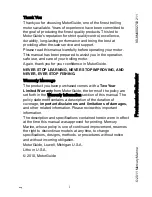
D-18
X6DAL-XTG User's Manual
(*Notes:)
* Before adding a new drive to an array, back up any data contained on the
new drive. Otherwise, all data will be lost.
* If you stop the Build or Clear process on a RAID 1 or RAID 10 from ACU
you can only restart it from Adaptec Storage Manager -Browser Edition.
(See
C-4
for details.)
* A RAID 1 created using the Quick Init. Option may return some data if you
later run a consistency check. This is normal and is not a cause for
concern.
* The ACU allows you to use drives of different sizes in a RAID 1 or RAID
10. However, during a build operation , only the smaller drive can be
selected as the source or first drive.
* When migrating from single volume to RAID 0, migrating from a larger drive
to a smaller drive is allowed. However, the destination drive must be at least
half the capacity of the source drive.
* Adaptec does not recommend that you migrate or build an array on
Windows dynamic disks (volumes), as it will result in data loss.
(
Caution
: Do not interrupt the creation of a RAID 0 using the Migrate option.
If you do, there is no way to restart, and no way to recover the data that
was on the source drive.)
5
When you are finished, press Done.
C. Initializing Disk Drives
If an installed disk does not appear in the disk selection list for creating a
new array, or if it appears grayed out, you may have to initialize it before
you can use it as part of an array. Drives attached to the controller must be
initialized before they can be used in an array.
!
(
Caution
: Initializing a disk overwrites the partition table on the disk and
makes any data on the disk unaccessible. If the drive is used in an array,
you may not be able to use the array again. Do not initialize a disk that is
part of a boot array. To determine which disks are associated with a
particular array, see the section-"
Viewing Array Properties"
.)
To initialize drives:
1. Turn on your computer and press Ctrl+A when prompted to access the
ARC utility.
2. From the ARC menu, select Array Configuration Utility (ACU).
3. Select Initialize Drives.
4. Use the up and down arrow keys to highlight the disk you wish to
initialize and press Insert.
5. Repeat
Step 4
so that both drives to be initialized are selected.
6. Press Enter.
7. Read the warning message and ensure that you have selected the
correct disk drives to initialize. Type Y to continue.
Содержание X6DAL-XTG
Страница 1: ...X6DAL XTG USER S MANUAL Revision 1 0 SUPER...
Страница 9: ...Chapter 1 Introduction 1 3 Introduction Figure 1 1 SUPER X6DAL XTG Image...
Страница 84: ...B 8 X6DAL XTG User s Manual Notes...
Страница 106: ...C 22 X6DAL XTG User s Manual Notes...
Страница 126: ...D 20 X6DAL XTG User s Manual Notes...



































